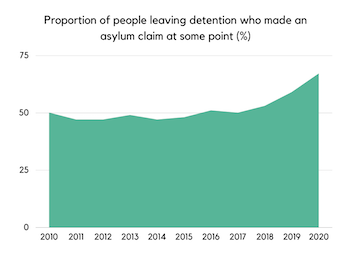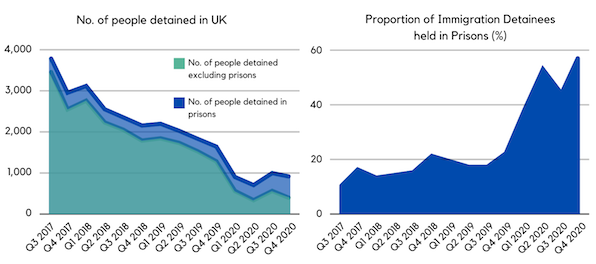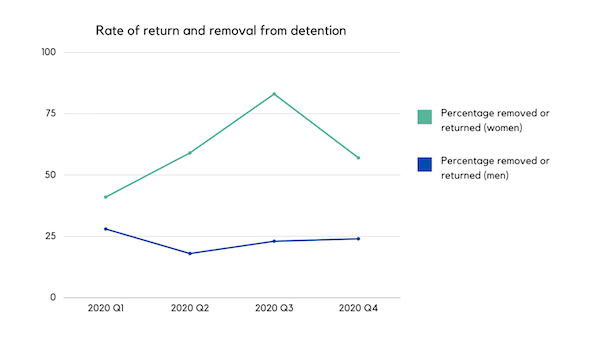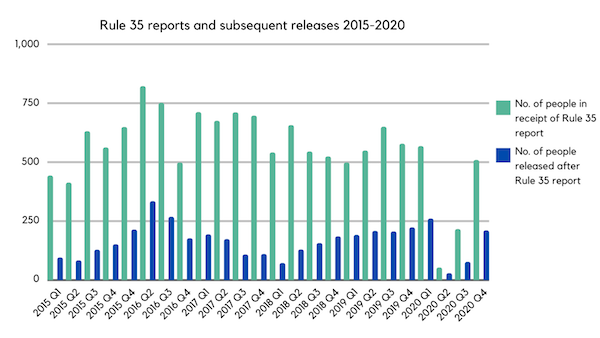Immigration Statistics 2020
The Home Office has released its statistics on immigration detention in the fourth quarter of 2020, giving the figures for the full year. During the year 2020, 14,773 people entered detention, down 40% since 2019 (24,443) and 15,449 people left detention, down 37% since 2019 (24,512). At year end there were 910 people in detention, down 44% since 2019 (1,637). The statistics are being reported in a slightly updated format.
(figures analysed and rounded by AVID)
Asylum claims
- 67% (10,320) of the people leaving detention in 2020 had made an asylum claim at some point, up from 59% in 2019.

Detention in prisons
- At the end of December 2020, 910 people were in detention, of whom 519 were in prisons (57%) representing a significant increase since December 2019, when 359 people were held in prisons (22% of people detained overall).
- On average, people are detained for longer in prison: of all those in detention at the end of December 2020, 14% (129) had been detained for more than 6 months, but 17% (88) of those held in prison had been detained for more than 6 months. Of those in detention at the end of December 2020, 6 people had been detained for between 2-3 years, 5 of whom (83%) were detained in prisons.
 Removal, release and length of detention
Removal, release and length of detention
- Between October and December 2020, 3,885 people entered detention and 3,916 left. Of those leaving in that quarter, 26% (1,002) were removed from the UK, and so 74% were released back into their community, their detention having served no purpose.
- Of those released from detention in the same quarter, 62% (2,433) were bailed by the Secretary of State (formerly ‘granted temporary admission or release’), <1% (17) were given leave to enter or remain, 11% (428) were bailed by an Immigration Judge, and less than 1% (36) left detention for ‘other’ reasons.
- The rate of return for women was higher than the rate of return for men in 2020. Of those leaving detention in 2020, 52% of women were removed as opposed to 24% of men.

- Only 7% of adults entering detention in 2020 were women (1,055), a number which has more than halved since 2018 when 15% of adults entering detention were women (3,644).
- In the first quarter of 2020, 562 women entered detention. The entry rate dropped significantly between April and June 2020 when only 78 women entered detention. Between July and September, the number of women who entered detention had increased again to 175 and again to 240 in the final quarter between October and December 2020.
- In the full year January – December 2020, 15,449 people left detention. Of these, 4,048 (26%) were removed from the UK, and so 74% were released from detention back into their community, their detention having served no purpose.
- Of those released in 2020, 60% were granted bail by the Secretary of State – a number which used to be referred to as being given ‘Temporary Admission or Release’; <1% leave to enter/remain, 1% other, and 13% bail (Immigration Judge). You can find the statistics on the Home Office website here.
- Of those leaving detention in 2020, 89% (13,690) were detained for less than two months, 9% (1,334) for between two and six months and 2% (320) for between six and 12 months. Of the <1% remaining (105 held over a year), 97 people had been in detention for between one and two years, 7 people for between two and three years, 1 for three to four years.
Nationality
- The most common nationality of people entering detention in 2020 was Iranian, accounting for 13% of the total (1,852), and a 5% increase on the previous year. The next most common nationality of people entering detention was Albanian (1,749), which is around half the number for 2019. While most other nationalities saw a reduction in numbers entering, there were increases in the number of people with the following nationalities: Sudanese (914), Eritrean (675) and Syrian (617).
- The nationalities with the most people removed in 2020 were Romanian (763), Brazilian (533), Albanian (482), Polish (332), and Lithuanian (237).
Children in detention
- Between January and December 2020, 23 children entered detention in the UK, down from 98 children in 2019
- 12 of these children (52%) were 17 years old, 8 were aged 12-16 (35%), 2 were aged 5-11 (9%), and 1 child was less than 5 years old (4%). Five of these children were detained in designated family units (1 in Tinsley House Family Unit and 4 in Gatwick Pre-Departure Accommodation) and 18 were detained in Yarl’s Wood IRC.
The Home Office also released its Immigration Enforcement Transparency Data for 2020.
- The average cost of detaining someone in 2020 was £97.66 per day, up from £91.43 in 2019.
- In 2020, 22 families were returned, which represents a large drop since 2019, when 71 families were returned.
- In 2020, 9 pregnant women were detained (down from 23 in 2019 and 45 in 2018).
- 55% of those in detention at the end of 2020 had a Rule 35 report, suggesting that over half of those in detention were ‘at risk’.
- On average 45% of those in receipt of a Rule 35 report in 2020 were released, up 16% since 2019. However, at the start of the pandemic, only 49 people were in receipt of a Rule 35 report between March and June 2020, down 91% since the same quarter in 2019 when 545 were written.

Publication date:
Friday, March 5, 2021




